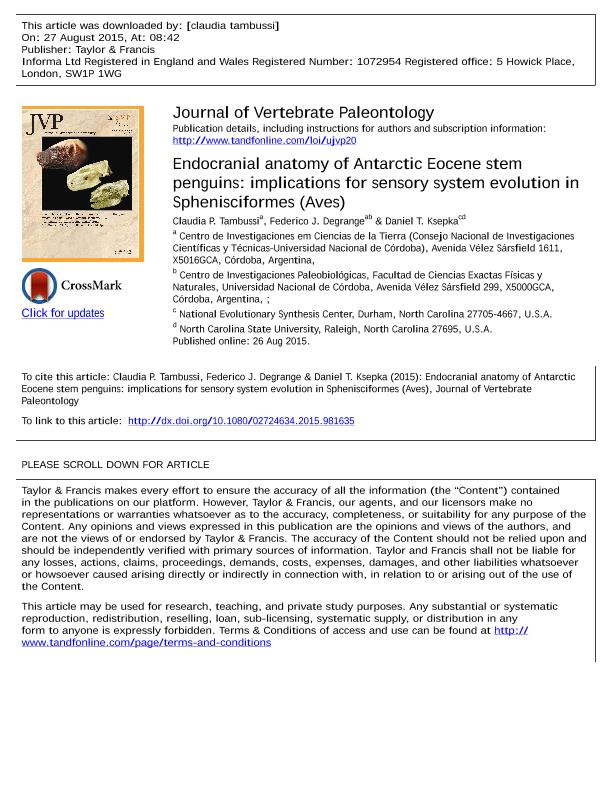Artículo
Endocranial anatomy of Antarctic Eocene stem penguins: implications for sensory system evolution in Sphenisciformes (Aves)
Fecha de publicación:
08/2015
Editorial:
Society of Vertebrate Paleontology
Revista:
Journal of Vertebrate Paleontology
ISSN:
0272-4634
e-ISSN:
1937-2809
Idioma:
Inglés
Tipo de recurso:
Artículo publicado
Clasificación temática:
Resumen
Penguins have a more than 60 million year long evolutionary history. Thus, stem lineage fossil taxa are key to understanding their evolution. Here, we present data on three virtual endocasts from stem penguin skulls collected from the Eocene La Meseta Formation of Seymour Island (Antarctica), along with comparative data from extant penguins and outgroups. These fossils appear to belong to three distinct species, and represent both the oldest (34.2 Ma) and the most basal penguin taxa that have yielded endocast data. Data collected from the fossils provide new support for several important shifts in neuroanatomy and cranial skeletal anatomy along the transition from stem to crown penguins, including (1) caudal expansion of the eminentia sagittalis, (2) an increase in the overlap of the telencephalon onto the cerebellum, (3) reduction of the bulbus olfactorius, and (4) loss of the interaural pathway. The large semicircular canal diameters of the Antarctic fossils as well as the more crownward stem penguin Paraptenodytes antarcticus together suggest that canal size increased in basal penguins relative to outgroup taxa but later decreased near the crown radiation. As in most other wing-propelled diving birds, the endocasts lack evidence of cerebellar folds and possess a relatively large floccular recess. Several aspects of the endocast morphology, including the exposure of the tectum opticum in dorsal view and the rostral displacement of the eminentia sagittalis away from the border of the cerebellum, are seen neither in crown penguins nor in Procellariiformes (the extant sister clade to Sphenisciformes) and so appear to represent unique characters of these stem taxa.
Palabras clave:
Evolucion
,
Cerebro
,
Organos de Los Sentidos
,
Spheniscifornes
Archivos asociados
Licencia
Identificadores
Colecciones
Articulos(CICTERRA)
Articulos de CENTRO DE INVEST.EN CS.DE LA TIERRA
Articulos de CENTRO DE INVEST.EN CS.DE LA TIERRA
Citación
Tambussi, Claudia Patricia; Degrange, Federico Javier; Ksepka, Daniel T.; Endocranial anatomy of Antarctic Eocene stem penguins: implications for sensory system evolution in Sphenisciformes (Aves); Society of Vertebrate Paleontology; Journal of Vertebrate Paleontology; 35; 5; 8-2015
Compartir
Altmétricas




